This article may contain affiliate / compensated links. For full information, please see our disclaimer here.
Basra is the second biggest city and the “financial capital” of Iraq, close to the Iranian and Kuwaiti border in the south. Basra has become the most important international port in the Gulf during the British after WWI. It is not its tourist attractions but its location along the Shatt Al-Arab that makes it a vital city in Iraq. This travel guide answers your questions about everything you need to know about the port city, including the best places to visit in Basra, where to sleep, and what to eat.
- What you should know about Basra
- More articles about Iraq
- Is it worth visiting Basra?
- How to get to Basra?
- What is the best time to visit Basra?
- What are the best places to visit and things to do in Basra?
- Places to visit around Basra
- Where to sleep in Basra?
- What are the best places to eat in Basra?
- More articles about the Middle East
- More articles about Iraq
What you should know about Basra
Basra is the principal port of Iraq on the shore of Shatt Al-Arab, which is formed by the confluence of the Tigris and Euphrates rivers and ends in the Persian Gulf . It does not have, however deep water, so the Umm Qasr port handles all of that, 60 km to the south. The city was well-known as a fertile agricultural landscape, but global warming increased water salinity and desertification, and the extensive palm groves are of the past by now.
The city was once full of different religious groups: Shiites, Sunnis, Christians of all sects, and ancient communities like the Sabean Mandaeans, Armenians, and Jews. Although many, other than the Shiites, have left, Basra is still a mix of different ethnic groups. An Afro-Iraqi population, known as Zanj, arrived as slaves from Africa from the 900s.
However, Basra is not without a history. Basra was the first city that the Arabs founded next to Zubair village, 15 km away in the 7th century, as a garrison encampment for the Arab tribesmen of the ruling Caliph. It rapidly grew into the second-largest city in Iraq, if not the entire Islamic world. It was an important cultural and trade center, and some famous poets and religious scholars turned up during this period, like Hassan al-Basri, whose tomb is in Zubair. New Basra replaced it in the late 900s, which had a much more favorable location on the banks of the Shatt Al-Arab.
New Basra prospered in the 19th century thanks to trade relations with Europe and America. At the beginning of WWI, the British occupied Basra, and it was part of the British mandate (1920 – 1932). The British quickly modernized the city, reconstructed the port, and invested in railways and an airport.
Its development continued during the Iraqi government and became the country’s date export center.
In the 1940s, the discovery of oil brought significant changes. Around the city are the largest oil fields in Iraq, making it the country’s wealthiest city. Most of Iraq’s oil exports leave from Al Basrah Oil Terminal.
Insurance: Safetywing is a cheap travel and medical insurance that also covers COVID-related issues in most countries, including Iraq.
Flights: Use Google Flights or Skyscanner to book your flight to get the best flight offers.
Many working-age people are absorbed by the petrol companies, where a big number of foreigners also work. For that, you can expect to meet more English speakers in Basra. The petrol companies offer attractive salaries to the employees, making other cities look at Basra with certain jealousy, as local people enjoy priority in the selection procedure.
The Rumaila oil field, 32 km from the Kuwaiti border to the south of Basra, is the largest oil field ever discovered in Iraq and one of the largest in the world. Iraq’s oil production is on the rise now. In March 2022, the oil ministry said that the country exported more than 100 million barrels for revenues of $11.07bn, the highest since 1972.
Basra has an old city penetrated by a complex system of canals. These used to transport people and goods, hence the name „Venice of the East”. Wealthy Kuwaiti and Saudi people spent their holidays in the idyllic city of Basra. Gulf Arabs, before the discovery of oil, used to flock to Basra for all-night entertainment. There were discos and cafes, and the party lasted till dawn on Sinbad Island. Traditional Khashaba (music of Basra performed with drum) parties were also held in the city.
On 22nd September 1980, using the debated status of the Shatt Al-Arab, Iraq launched an attack against Iran. The war that lasted 8 years causing the death of hundreds of thousands of people on both sides. There are still abandoned, half-sunk boats in the bay, occupied by homeless people now. During the war, Iran repeatedly shelled the city.
Basra suffered under one of the heaviest fights during the first and second Gulf Wars. After the first Gulf war of 1991, Basra was the hotspot of anti-Saddam rebellions who violently quelled the insurgence. During the war of 2003, the outskirts of Basra were the scene of bloody fights.
After that, Muqtada al Sadr’s (Shia scholar and leader of the Sadrist movement) Mahdi militia gained power, and a more conservative landscape replaced Basra’s vibrant nightlife with alcohol shops being closed.
In 2008, Prime Minister al-Maliki ordered a crackdown on militia in Basra, igniting frequent battles with Moqtada Sadr’s Mahdi army. Hundreds were killed.
More articles about Iraq
All you need to know before traveling to Iraq
How to spend 3-4 days in Baghdad
Ultimate travel guide to Mosul
What to visit in Babylon/Hillah
Is it worth visiting Basra?
Since Basra does not have famous historical sites, it is not so popular among travelers. However, Basra’s main attraction is its people, known to be the friendliest in the country. Already that makes it a place worth visiting.
Plus, you can only get a good overview of Iraq by visiting Basra, the port city of such importance. If you have the time, you should include it in your itinerary. Some sites of interest around Basra keep you busy for at least two days.
The fish and seafood are very famous in Basra, and they make it with more spices here.
How to get to Basra?
By night train from Baghdad: it costs 25 000 IQD if you choose a shared compartment. There is different information about which day you can take the train, they usually left on Fridays, Saturdays, and Sundays, but somebody took it on a Thursday recently, so it may be more frequent now. You should always check before. You can take the night train back to Baghdad as well. Show up at least half an hour before departure as they carefully check all the luggage.
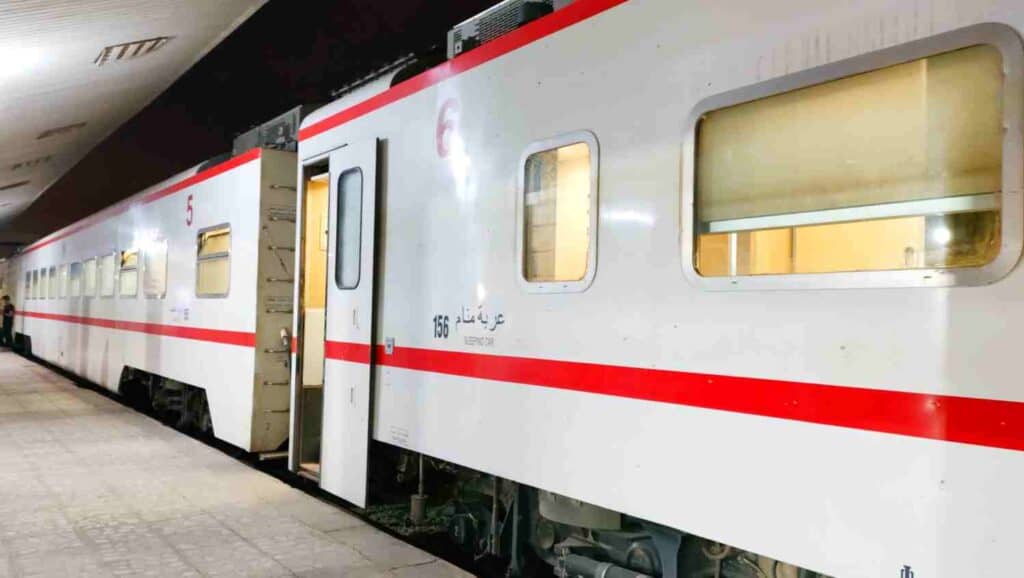
By shared taxi: You can reach Basra from every big city with a shared taxi.
- From Baghad: 35 000 IQD (4 people), 50 000 IQD (3 people) and takes 5 hours
- From Qurnah: 1 hour
- From Nassiriyah: 2 and a half hours,
By flight: Basra has an international airport, where a visa on arrival is also available for foreigners. There are flights from Istanbul, Dubai, Doha, Amman, Baghdad, Erbil, and Sulaymaniyah.
Arriving via land from Iran and Kuwait: Basra is close to the Iranian and Kuwaiti border, and you may travel from one country to another. You can now get a visa on arrival at the land borders to enter Iraq if you are citizens of the EU, UK, Switzerland, USA, Canada, Russia, China, South Korea, Japan, Australia & New Zealand.
What is the best time to visit Basra?
Basra is one of the hottest cities in the world, so you should be cautious about the time you visit it. During summer (June-August), the temperature can reach 60 degrees. High humidity – sometimes exceeding 90% – is common due to the proximity to the Persian Gulf.
Even Basra gets cold during winter, and the temperature can sometimes drop below zero.
The best time to visit Basra is March-May and October-November.
What are the best places to visit and things to do in Basra?
1. Basra Museum – one of the best things to do in Basra
Reopened to the public in March 2019, the museum has a remarkable collection with four galleries dedicated to the Assyrian, Sumer, Babylonian, and Islamic civilizations. It has some artifacts on display from the southern province that date back to 6000 BC.
The building that gives home to the new museum is another interesting story.
The museum closed in 1991 after anti-Saddam rebels looted it. Half of its objects were stolen, and the director was shot dead at that time. The remaining antiquities were sent to Baghdad for safekeeping, but some of them were later stolen during the 2003 invasion what was called one of the biggest archeological tragedies in history.
After the war of 2003, the museum building served as a base for British soldiers. It was in an old courtyard house in an insecure part of the town, not suitable to house such high-value archeological artifacts.
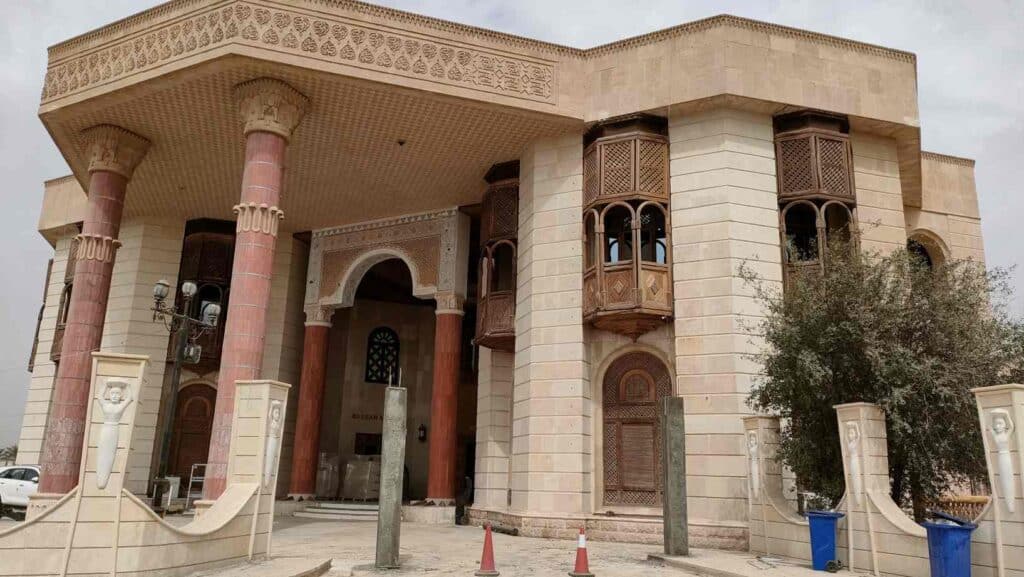
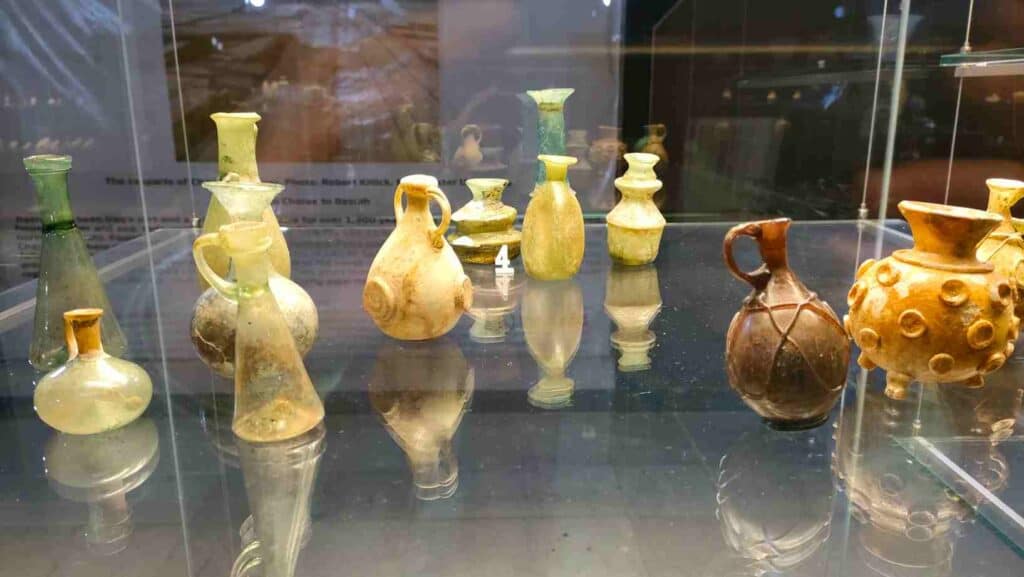
So, they relocated the museum to the former palace of Saddam Hussein in the so-called palace area that is marked by a huge entrance gate along the riverbank. The palace also needed comprehensive reconstructions. Choosing Saddam’s former residence to accommodate the new museum was controversial. However, it had a fantastic location along the Shatt al-Arab, and after the reconstruction, it was the perfect place for the purpose. Especially its unique ceiling catches the eye. It was one of the 70 palaces that Saddam built throughout the country. Iraqi people had little idea about what happened behind the walls of these palaces.
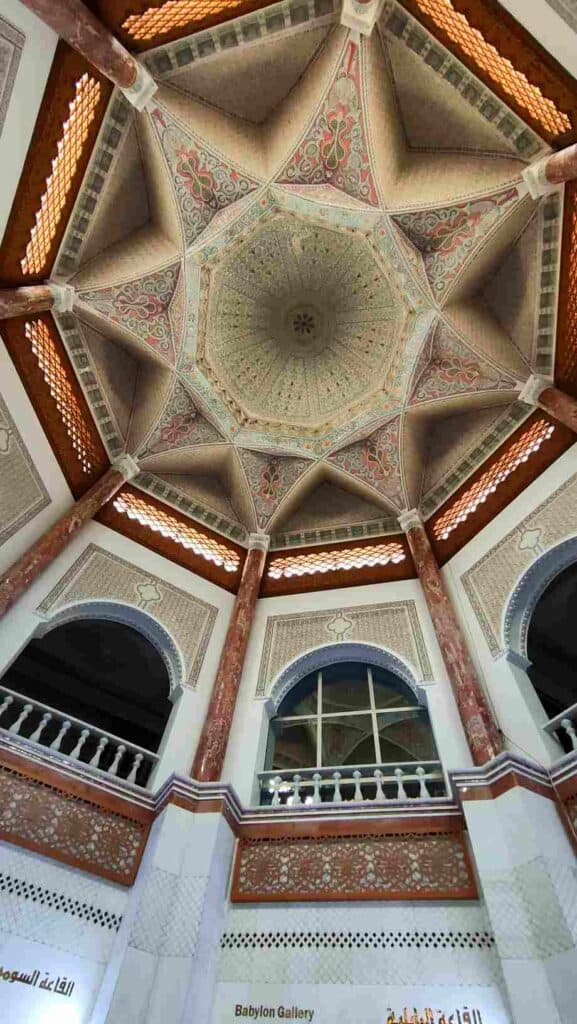
The British Museum was one of the main donators of the new museum that helped restore the galleries and gifted thousands of books to its library. The museum displays a remarkable collection of cuneiform clay tablets that Sumerians used as the first way to write 5000 years ago.
The museum has bilingual Arabic-English descriptions, making it enjoyable for non-Arabic speakers as well.
There are plans to turn the area into a cultural complex.
Opening hours: 8 am- 2 pm, closed on Friday and Saturday
Entrance fee: 25 000 IQD
2. The Italian bridge
The iconic bridge spanning over the Shatt Al-Arab is one of the landmarks of Basra. It was completed in 2017 by an Italian contractor. For that, everybody simply calls that the Italian bridge. The bridge largely eased the connection between the center and the suburbs of Basra.
You may feel tempted to stop in the middle at the bridge’s highest point; however, the driver immediately gets fined if noticed by the police. Don’t worry. You can take an excellent photo of Basra from the top of the Basra hotel.
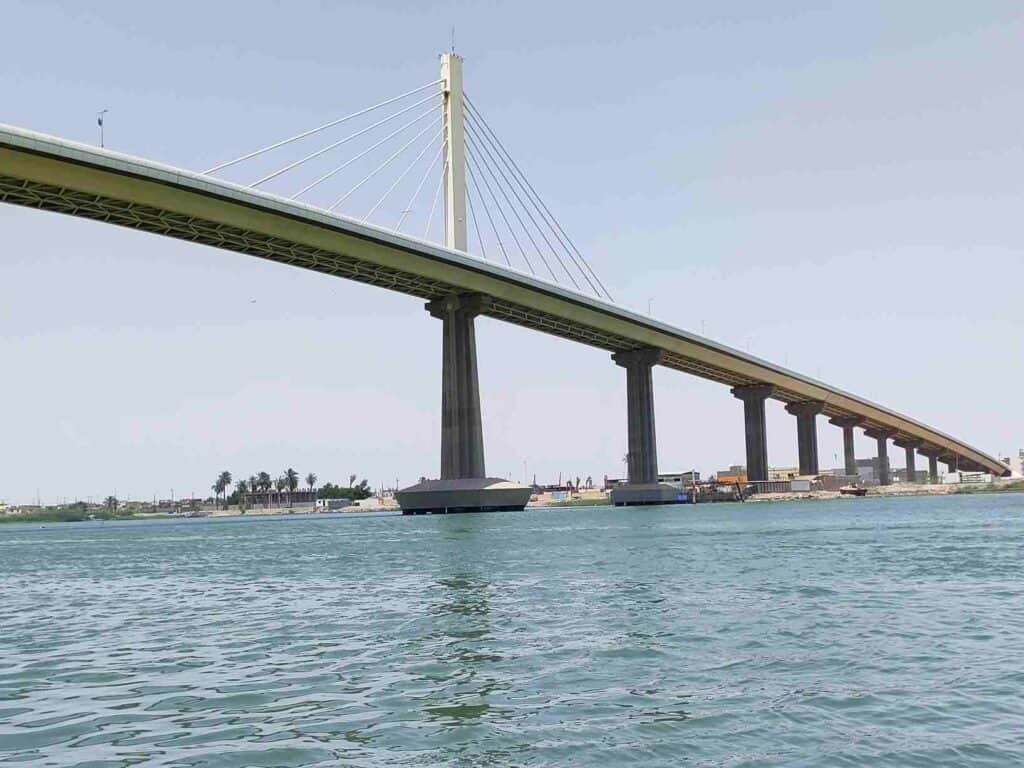
3. The Al Ashar Bazaar near the Ashar river
Next to the Corniche amusement park, the Ashar river diverges from the Shatt-Arab. Along the river, you can stroll around in the central bazaar of Basra with countless shops, each street selling different products.
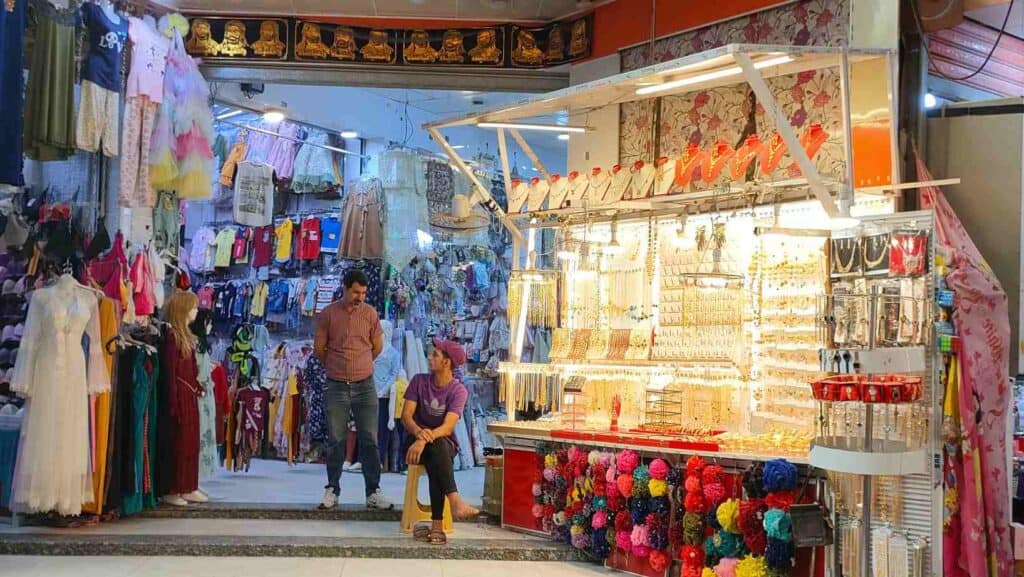
4. Corniche (old and new)
Walk along the Corniche (riverside promenade), the most popular place for families. During the war with Iran, Saddam placed the life-sized statutes of 99 generals pointing to Iran together with his own along the Corniche. The statues have since been removed.
The most famous five-star hotel, the Basra International, initially the Basra Sheraton Hotel, also stands here and a former boat of Saddam Hussein is stranded along the Corniche.
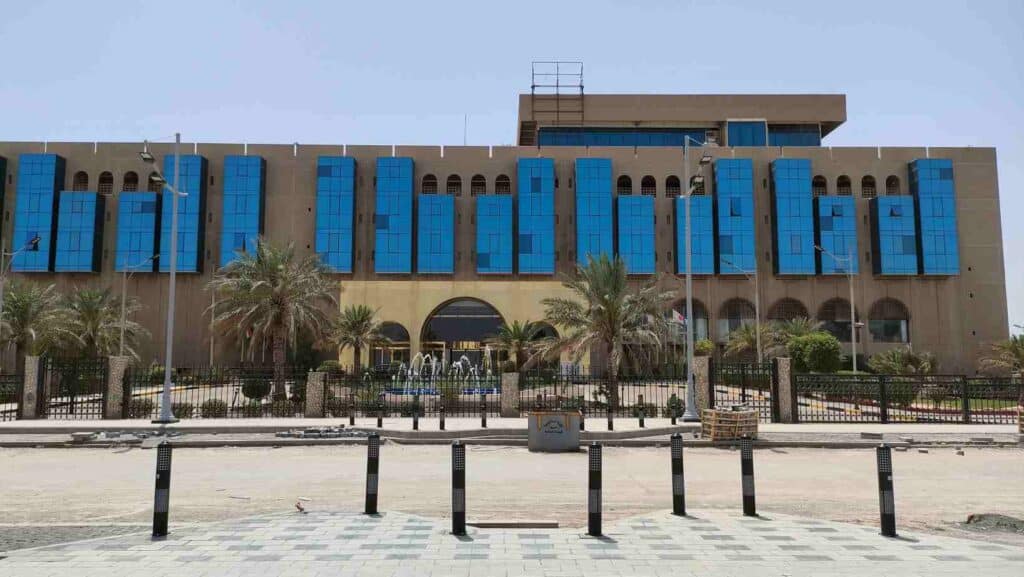
The Corniche is under reconstruction, with new pavement being laid down and palm trees planted in the middle. But locals have already come to walk there.
Along the Corniche at the amusement park stands the statue of the most respected poet Badr Shakir al-Sayyab, one of the greatest poets of the Arab world in the 20th century.
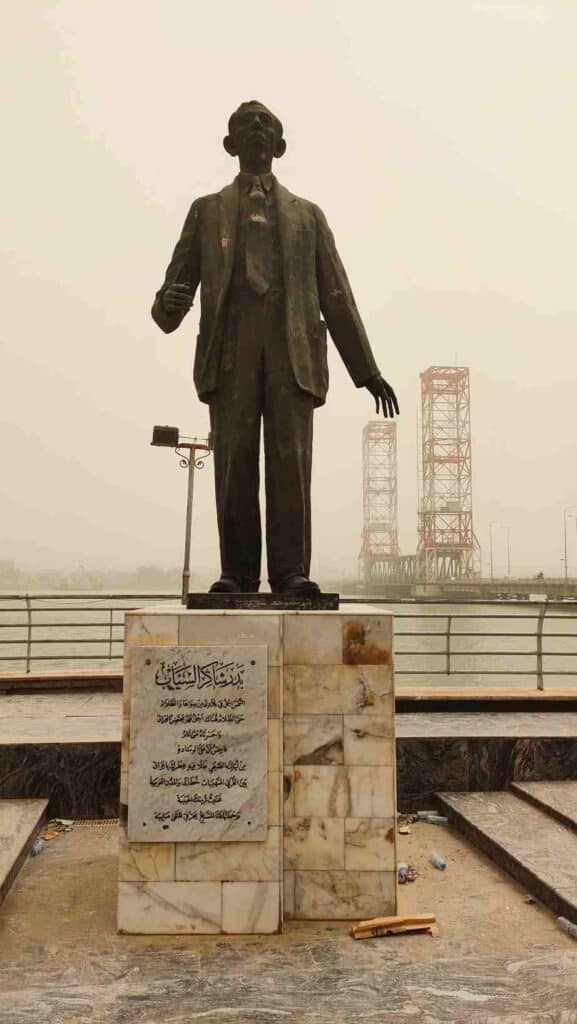
5. Walk inside the old city with the finest examples of old Basra houses with “Shanasheel”
Shanasheel is an Iraqi word for the finely crafted bay windows with intricate wooden latticework and stained glass on the upper floor of the buildings. They caught the wind and served as natural cooling systems.
The Shanasheel often belonged to the biggest and most beautiful room in the house. It also reflects the conservative society’s customs and traditions, enabling the residents to have a good view of the street without being seen.
The houses decorated with Shanasheel belonged to wealthy aristocrats and date back to the 16th – 17th centuries. There is still a neighborhood near Ashar where you can observe these mansions that are the symbols of Basra. Unfortunately, they are quite neglected.
Insurance: Safetywing is a cheap travel and medical insurance that also covers COVID-related issues in most countries, including Iraq.
Flights: Use Google Flights or Skyscanner to book your flight to get the best flight offers.
Shanasheels are made of wood abundant in Basra as it was a port, a storage city, and was exported abroad. Cheap foreign labor was also available, and the Basra citizens had the money to build such decorative houses. They mostly used teak wood because it can resist the high humidity, so common in Basra. Besides, they also used apple, sandal, and coated the woods with a distinctive rose fragrance, giving it a unique odor that became familiar to the residents and visitors of old Basra.
The open inner courtyard is the main architectural element of these mansions. Some of the wealthiest even paved them with tiles, imported mainly from Pakistan and Italy. The courtyard was a practical solution to pull the cool air in the evening from above. It kept a pleasant temperature until noon when the sun rays reached the ground.
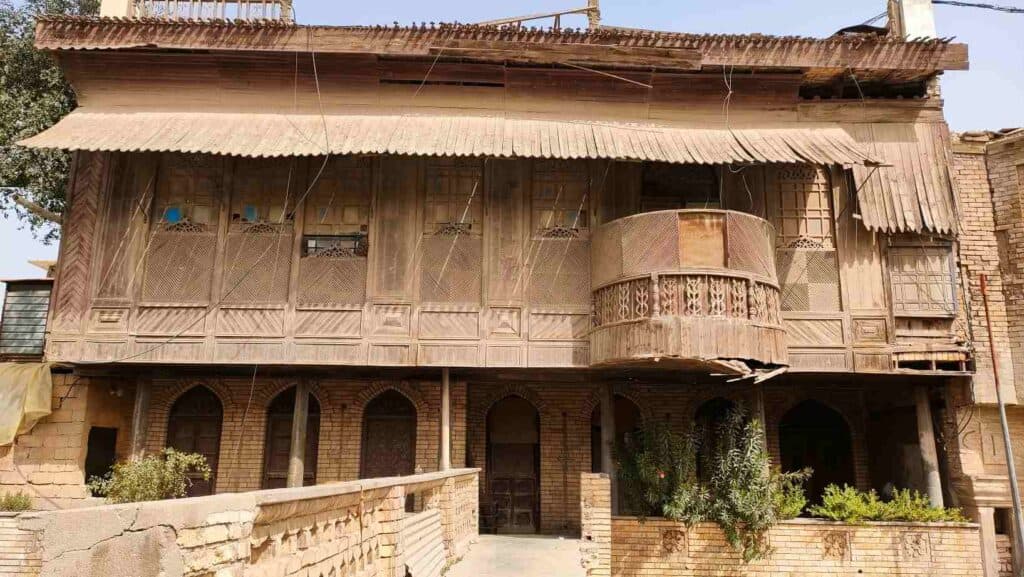
The doorway was also pivotal to the Shanasheel building. Often, its decoration reflected the richness of the house. Most of the doors were made of teak wood, the best quality wood adorned with geometric and floral motifs and door knockers of different shapes. The ceilings were built of jandal wood, often imported from abroad and arranged in parallel at equal distances.
There are different styles of Shanasheels: enclosed, balcony, mixed, or extending along its length and overlooking the alley, etc.
6. Al-Markaziya, the oldest school of south Iraq
Take a photo of one of the historic buildings of Basra, close to the Ashar river. The secondary school for boys was built by the British in 1920 and opened in 1925.
Right next to that opens the “Ladies” market” with shops selling mainly cosmetics, textile, kitchen utensils and anything that mainly women like.
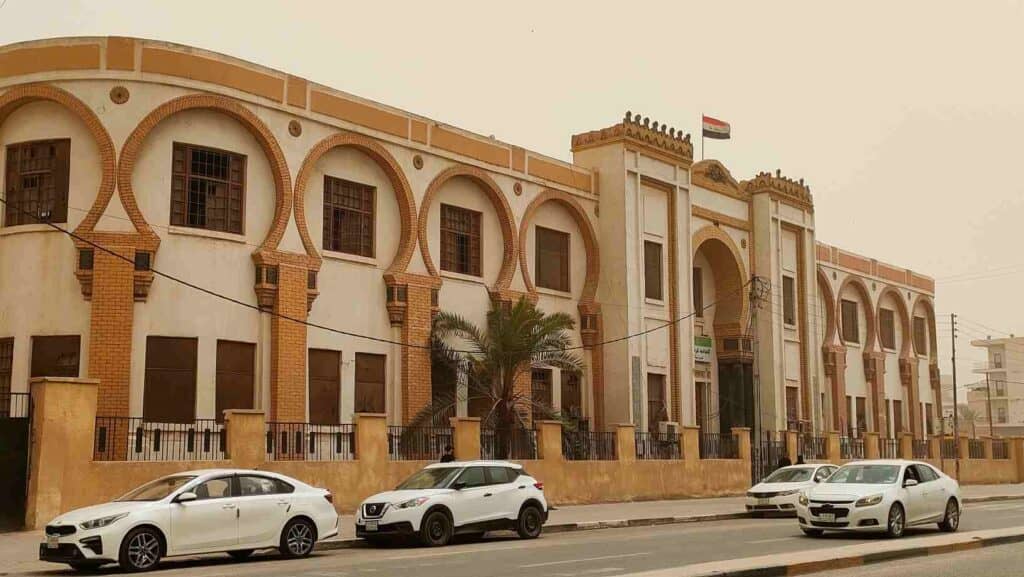
7. Take a boat ride on the Shatt Al-Arab River
Do not miss taking a small boat along the corniche opposite the Basra International hotel to have a 20-minute ride on the river that was part of the border debated between Iran and Iraq and now a main transport route of Iraq.
The boat ride takes you to the Basra Museum (the palace area of Saddam Hussein) along Saddam yachts, passing under the iconic bridge of Basra. As it is often too hot in Basra, it is a perfect way to get refreshed.
Price of the normal ride is: 10 000 IQD, a special longer ride costs 20 000 IQD.
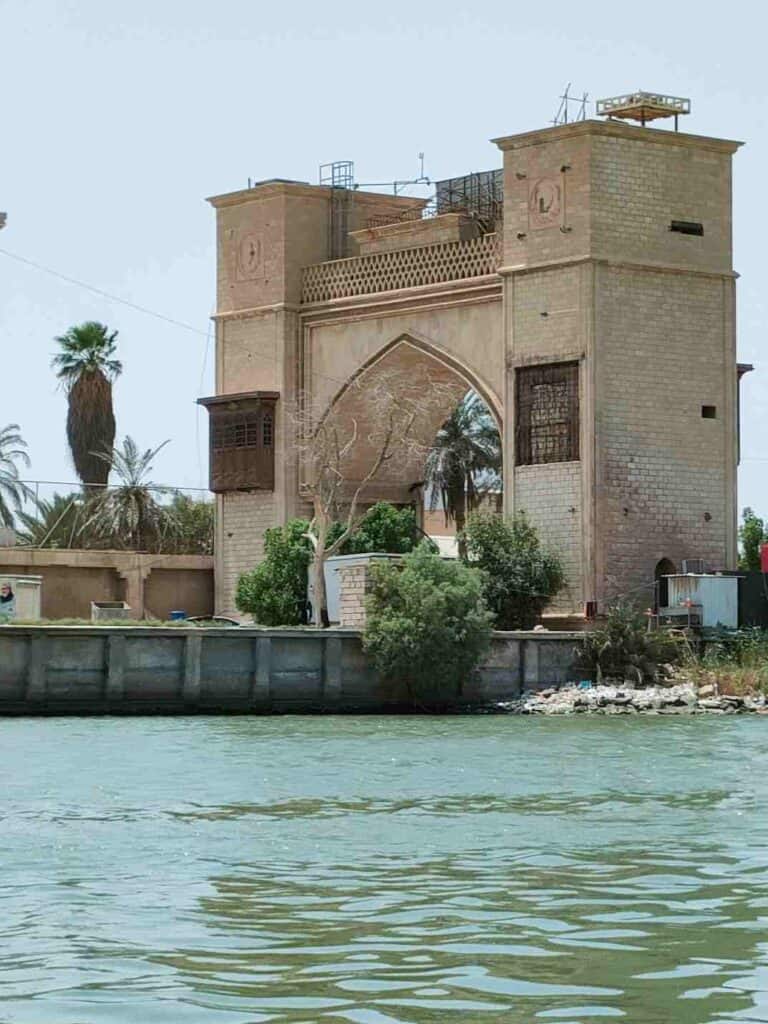
8. Visit some of the Christian Churches of Basra
Once a large community in southern Iraq, by now a thousand in Basra and a few hundred in Nasiriyah and the Mandeans. The Latin Church is a nice example, located on the 14th of July Street.
9. Enjoy the best view of Basra from the top-floor restaurant of the Basra hotel
From here you can probably get the best view of Basra with the bridge and the Shatt Al-Arab.
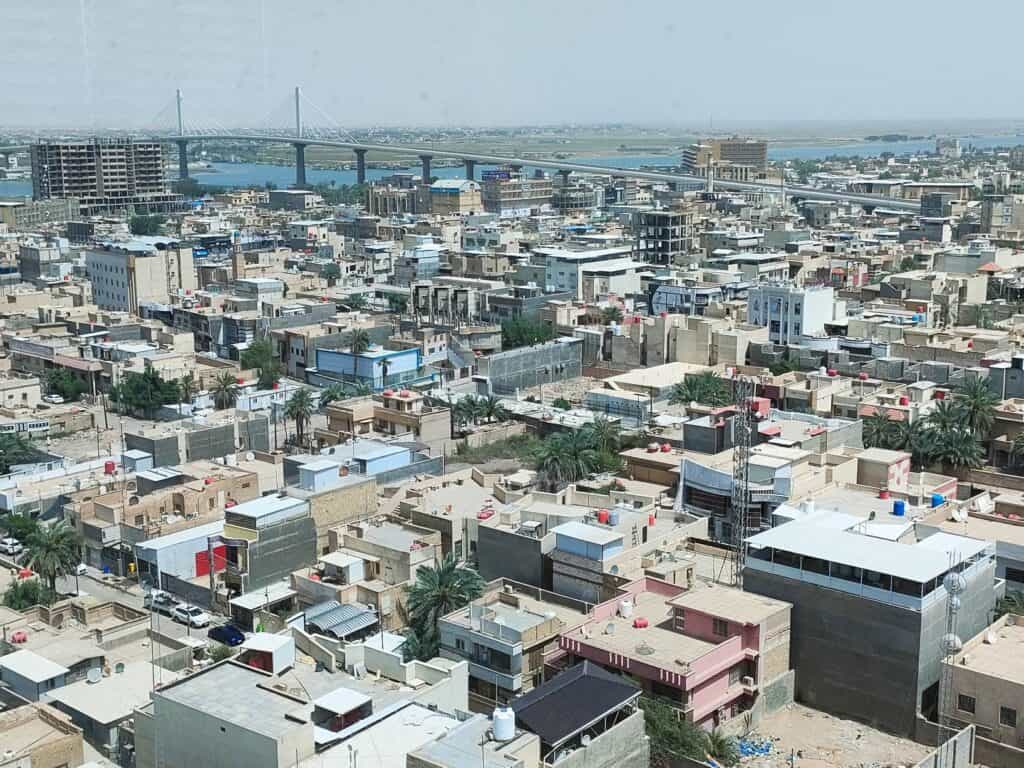
10. Al Maaqal Private University Basra
Its unique architecture makes it one of the most impressive buildings in Basra, located close to the Al-Maqal port. Thanks to my friend and the university, I could have a tour inside the building. Entering the main gate, I felt like arriving at a hotel’s reception. Everything is shiny and perfect. Well, it is a private University where students pay tuition fees. It was late afternoon, so only a few students walked around, and most classes were over. Still, I received a warm welcome. They showed me an impressive introduction video about the university, its faculties, and future plans.
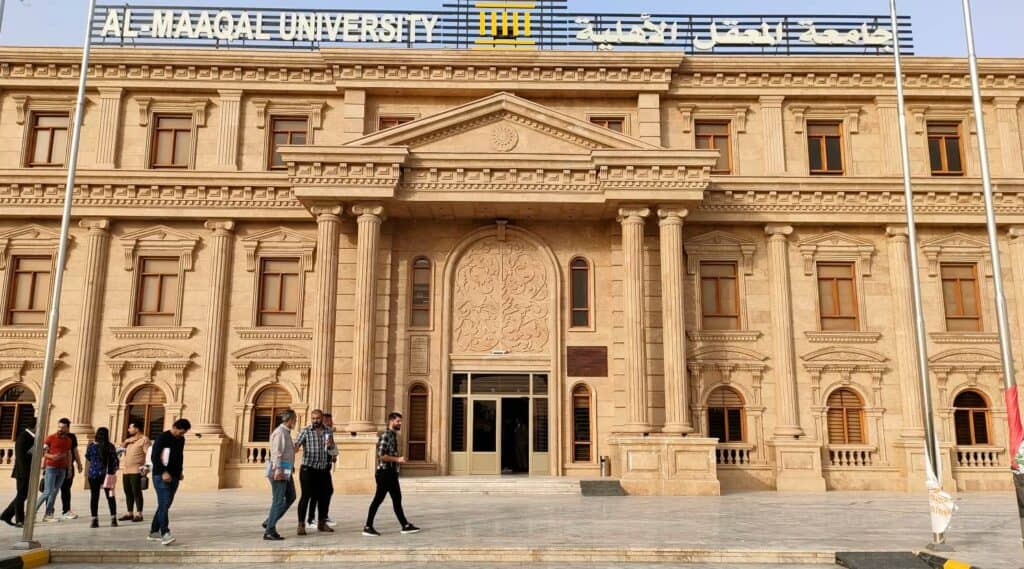
I was invited to attend the English Literature class with honestly one of the funniest teachers ever. They showed me the laboratory of the faculty of dentistry and introduced me to some of the professors.
Behind the university, Saddam’s enormous grey ship stands abandoned.
For its impressive architecture, I would recommend for everybody stop to have a look even only from the outside.
11. Visit the Imam Ali Mosque – one of the oldest mosques in Iraq
The Imam Ali Mosque, located on the city’s outskirts toward Zubair, is Basra’s most important religious site. It was the first mosque outside the Arab peninsula after the Arab contest, where the first Shia Imam, Ali was praying as well. Since then, it has been a famous pilgrimage site. It was rebuilt many times, the last time by Saddam Hussein. However, only the alone-standing minaret survived from the ancient mosque that dates back to the 7th century. Women and men have separate sections to pray near the ancient minaret.
Ali delivered sermons and taught jurisprudence, grammar and philosophy in Basra.
Women must wear an abaya to enter. It is open all day and is nicely illuminated in the evening.
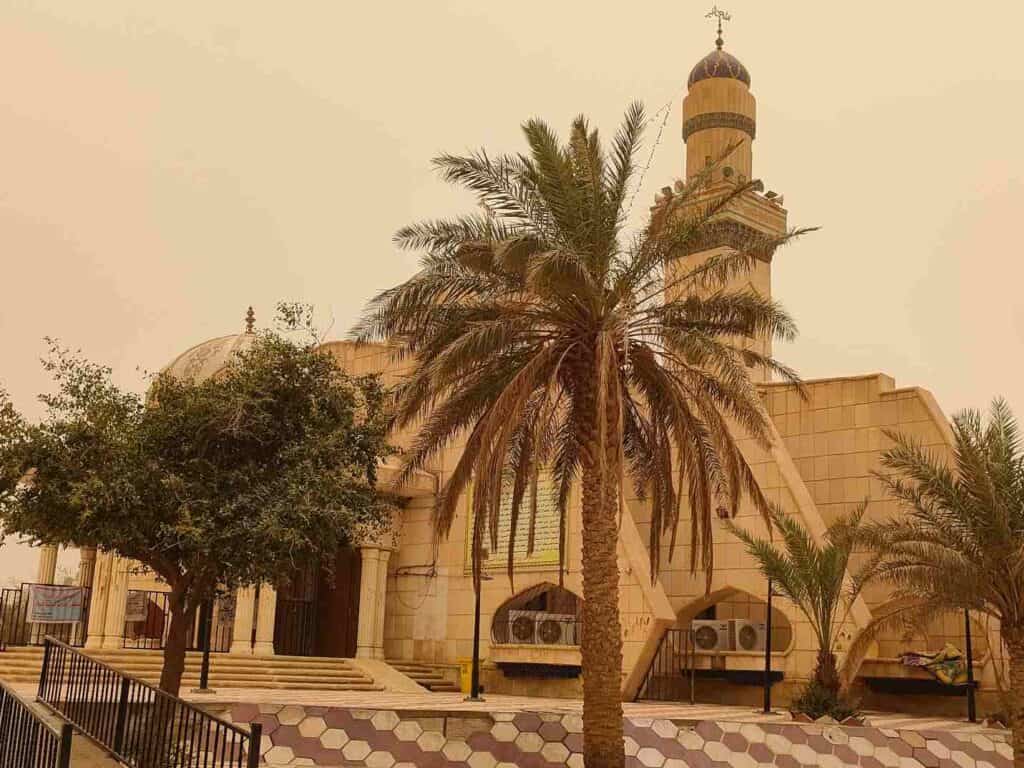
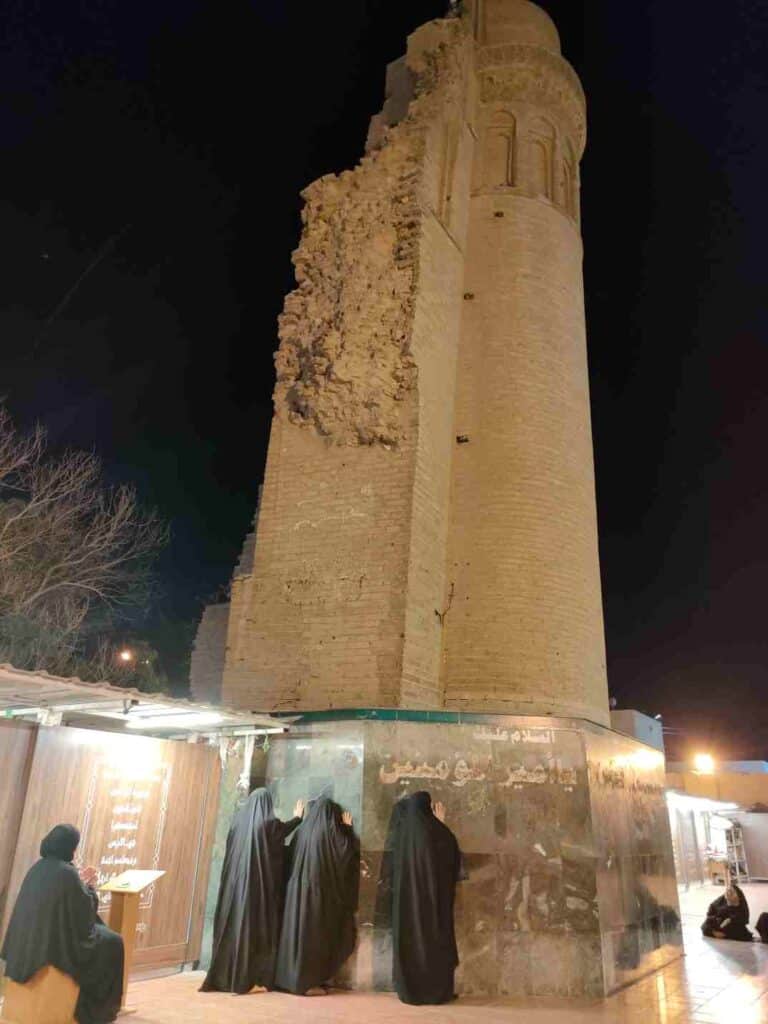
12. Basra Sport City – the largest sport facility in Iraq
The Basra sports complex is in the suburbs of the city. After four years of construction, it was completed in 2013 for the Gulf Cup of Nations, but due to security reasons as moved to Bahrain. It has a 65-000 seat soccer stadium in the center that resembles a date palm from the outside, a symbol of Basra. The surrounding artificial lake is in the shape of Iraq. There is a secondary stadium, training fields, and hotels in the park as well.
Iraq played the first international home game in four years at the stadium on 1 June 2017, beating Jordan 1–0.
On 10 October 2019, Iraq played its first competitive international game at home after eight years against Hong Kong. The result was a 2–0 win.
The Basra sport city is the first such modern complex in Iraq aimed at making the city a sports center in the Middle East.
The stadium is illuminated in the evening, and people come here to stroll around. Often, there are some events, like the flower festival.
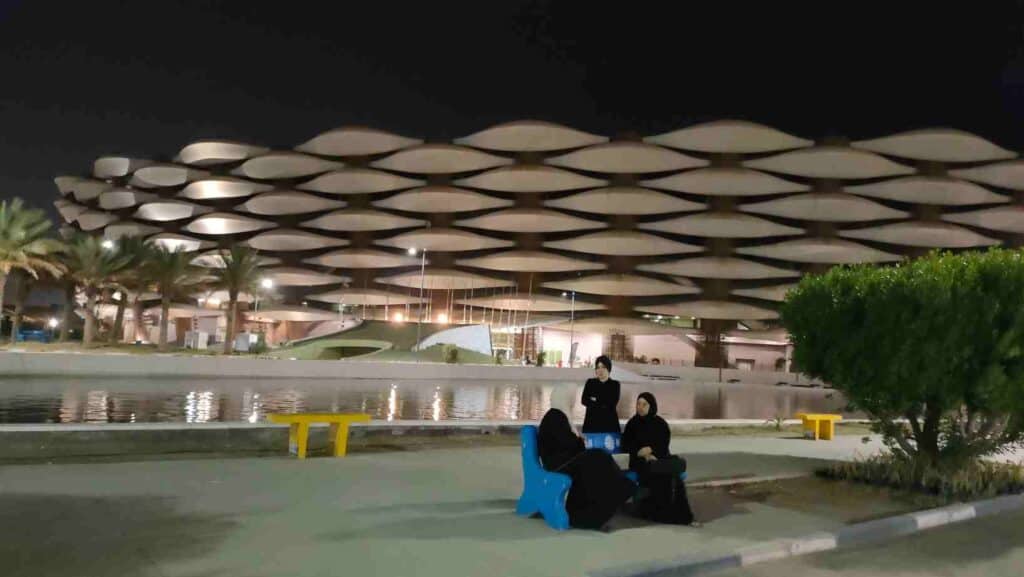
13. Sinbad island – once the Disneyland of south Iraq is in complete ruins
It is hard to imagine now that it was once a glamorous place of entertainment attracting visitors from Saudi Arabia and Kuwait. The island was named after Sinbad because, according to the legend, he started his sailing from Basra.
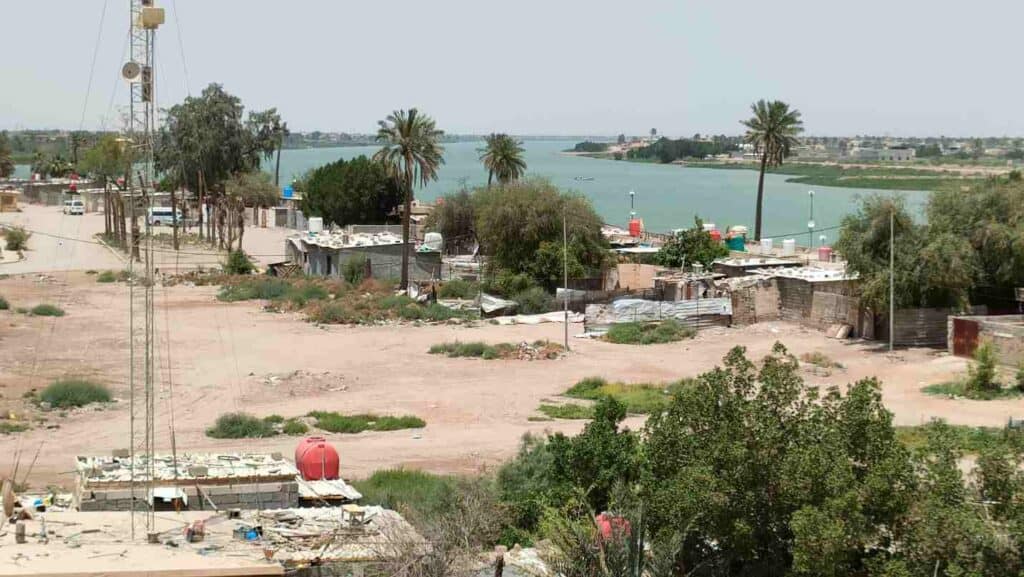
The island has a nice location in the middle of the Shatt Al-Arab, but apart from demolished and abandoned buildings, the houses of illegal dwellers, and some picnickers, there is nothing left of that splendor anymore.
The island had once a casino and nightclub, gardens, parks, resorts, and fountains with a range of restaurants, cafes, and recreational clubs. But after Saddam Hussein had lost control of the area in the 1990s, it was looted and fell into ruins.
There are plans to revive the island with a range of hotels, malls, green areas, and a water park. Once it is ready, Sinbad Island will become an attractive tourist destination.
Insurance: Safetywing is a cheap travel and medical insurance that also covers COVID-related issues in most countries, including Iraq.
Flights: Use Google Flights or Skyscanner to book your flight to get the best flight offers.
Places to visit around Basra
1. Zubair
Only 10 km south of Basra is the small town called Zubair. It has the historical importance that this is where first Basra was originally founded in the 7th century. The ruins are still seen, however, it is a kind of disappointment. Following the reconstructions, it looks quite unauthentic and artificial, plus a fence surrounds it with no access for visitors.
What is more interesting to visit in Zubair is not mentioned in any books or on the internet: it is the ruins of the former villa, the Mudachei palace of a Kuwaiti merchant. I found it more interesting than anything else in Zubair. Locals say that he found a sack of money from which he built it. It is along the main road heading before joining the highway to Kuwait.
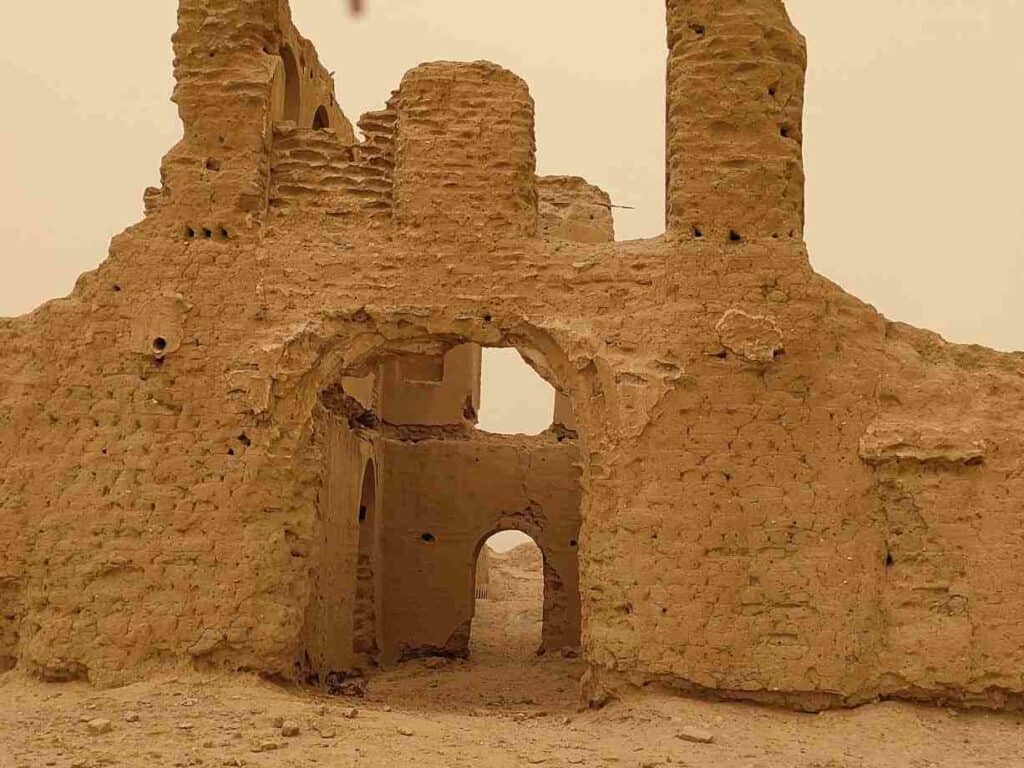
2. Abul Khasib – 26 km south of Basra
Although it is a separate city, it looks like Basra’s extension. Once, it was famous for the biggest number of date palms in Iraq, the largest exporter in the world.
It is also the birthplace of the famous Iraqi poet and journalist Badr Shakir al Sayyeb, whose statue stands along the Corniche in Basra.
Date production is unfortunately in a sharp decline in Iraq. There were countless date palm groves in the country with up to 30 million trees and 450 different varieties. Before the Iran-Iraq War (1980–88), Iraq was one of the world’s leading producers of top-quality dates, supplying over 60% of the world’s crop. The decades of wars, diseases, droughts, and construction projects took their toll on date production. The decline has mostly affected the southern Iraqi city of Basra, where more than half of the date palms have been damaged owing to war and high salinity levels in the water.
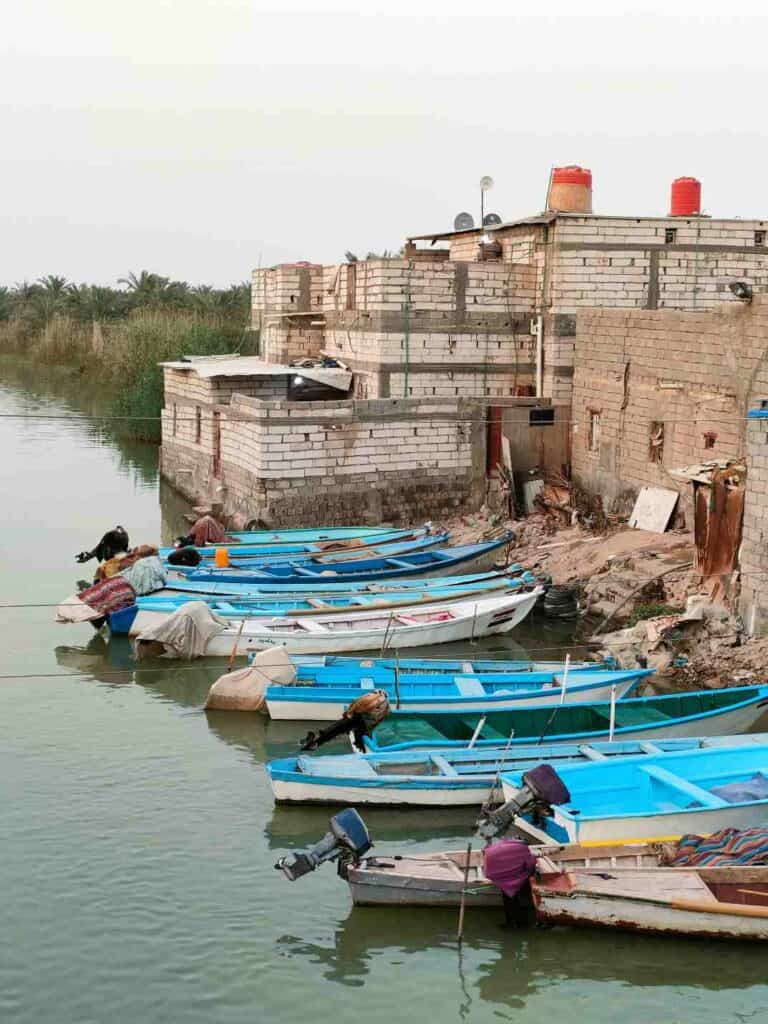
If you travel to Abu Khasib hoping to see the lush green fields of palm trees, then you may get disappointed, as it is really something of the past. This landscape can be more found around Hit and Haditha in the Anbar region.
However, some side canals of the Shatt Al-Arab still have nice restaurants, date palms, and a pleasant green environment.
3. Umm Qasr– Iraq’s largest deep water port.
It is probably not something of interest for most travelers. However, I wanted to share some information about visiting the famous port of Iraq. As I did not have such experience before, I found it fascinating, even during sandstorm time, when the visibility was far from perfect.
Umm Qasr was initially a small fishing village that developed into Iraq’s largest and only deep-water port, directly linked to the Persian Gulf. It is around 60 km to the south of Basra, only separated by a small inlet from Kuwait. It was founded in the 1960s to end the dependence on the Shatt Al-Arab river for transport, which marked the border with Iran.
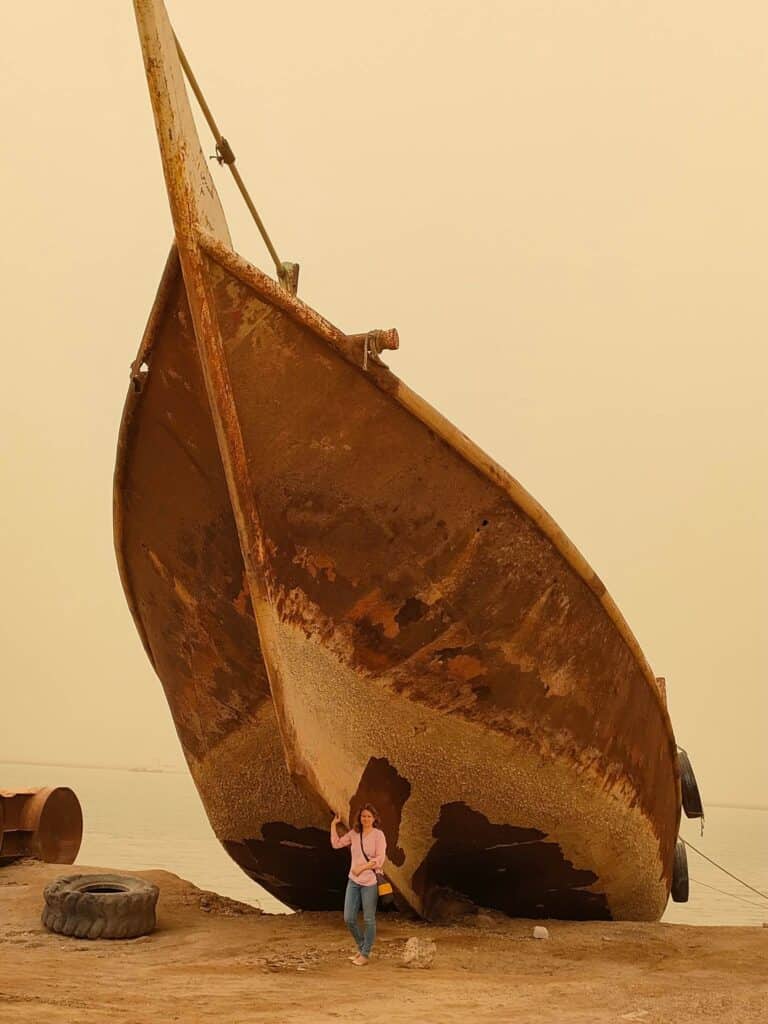
Trucks are waiting in endless queues to load and unload their cargo. Containers are piled up on top of each other, and cranes dominate the skyline in the background. The extraordinary logistics it involves are impressive. As we drove further deep into the port, we arrived at the shore with shipwrecks and some simple houses, the permanent home for some workers and their families.
How to visit: you can go there by private taxi only. There are more entrances to the busy Northern port, and although refused by one, we could enter at the other one. It is better to go in the morning when there is more traffic.
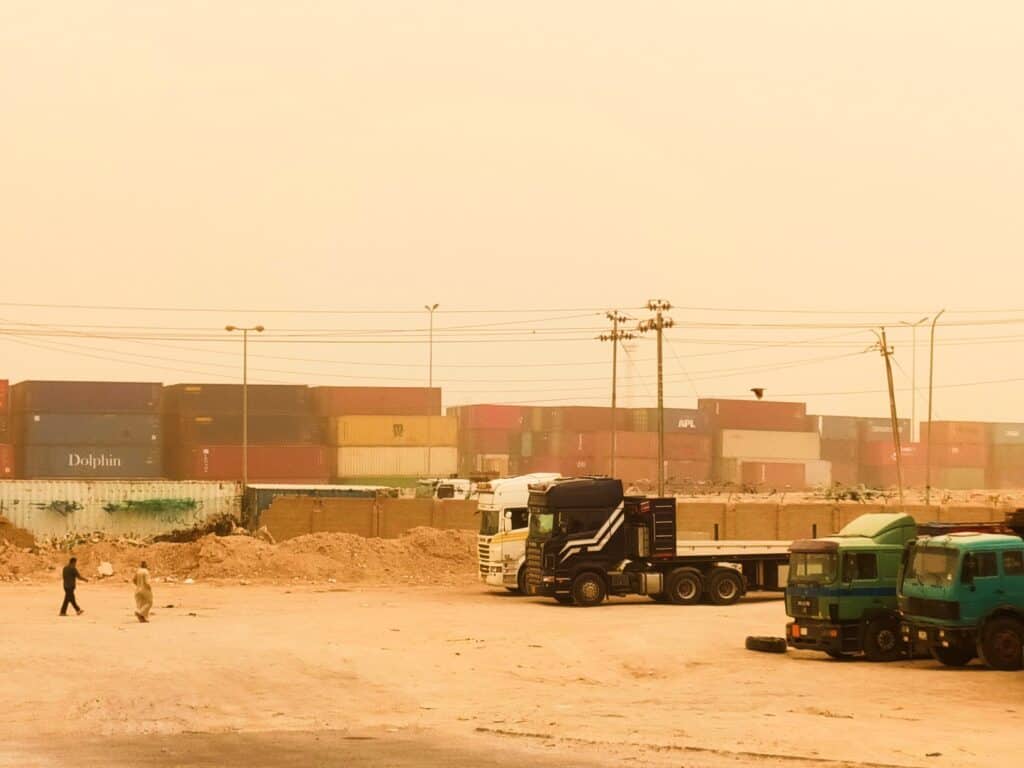
Where to sleep in Basra?
There is a range of cheap hotels along Istiklal street parallel the corniche. Locals recommend the Al Buraq hotel, which is clean and cheap for 25 000 IQD /night.
What are the best places to eat in Basra?
Zarzour restaurant: named after the bird, they can be found inside the restaurant building, There is an upper gallery.
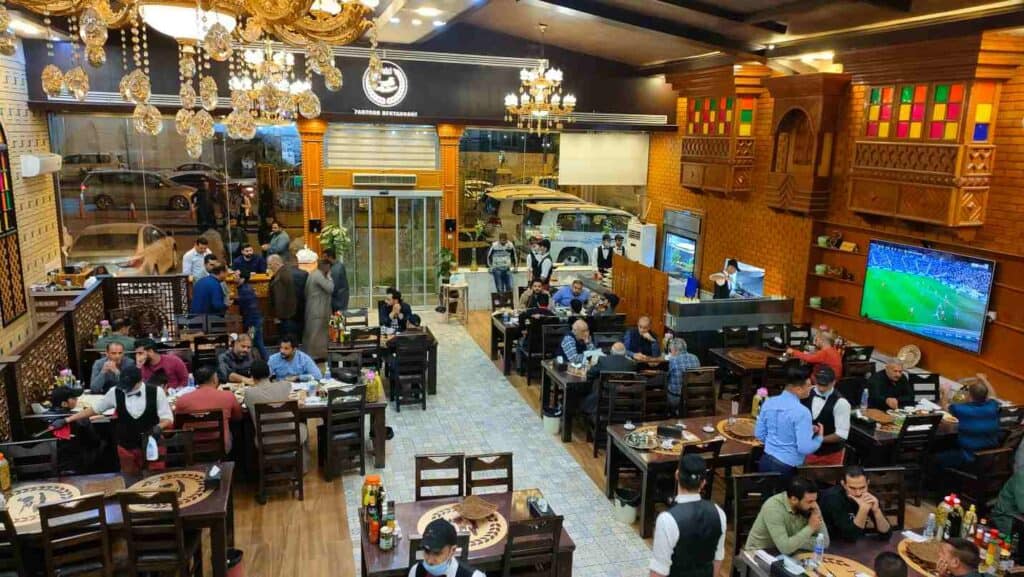
Shatt Al Arab restaurant: a high-class restaurant directly at the foot of the Italian bridge with a pleasant terrace.
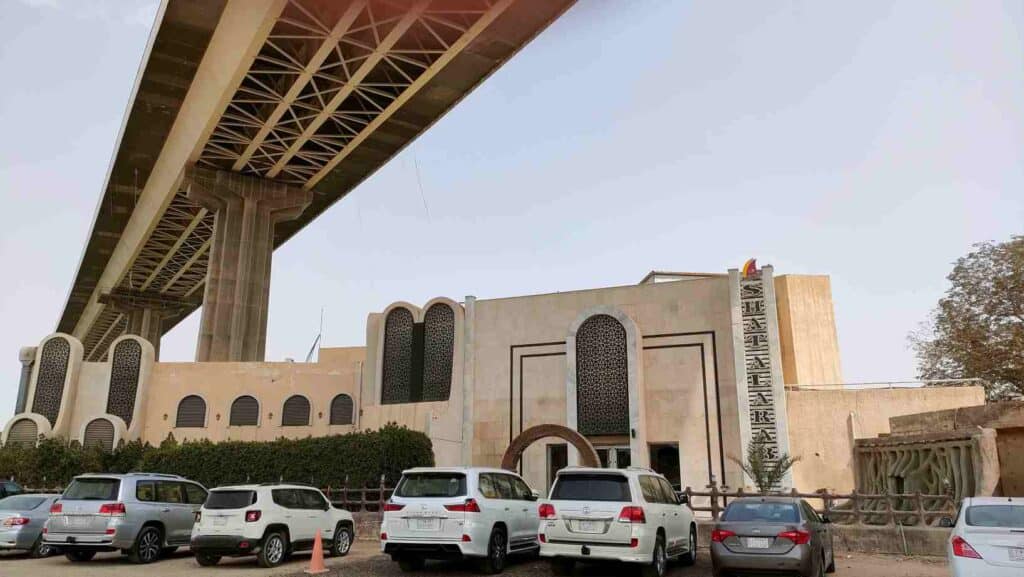
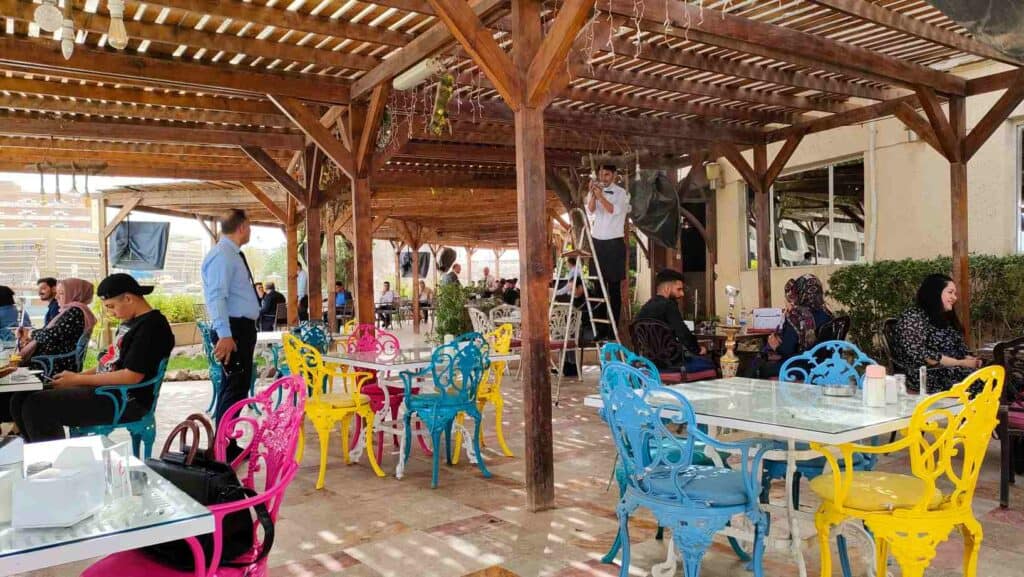
Monalisa restaurant – with separate section for men and families this is an elegant restaurant with an excellent buffet dinner in the center of the city.
Shanshal and Bastra Times Square malls: You may not be fond of shopping malls in your home country, but these are actually important scenes of evening life in Iraq. Shops are open till midnight, and it is busy till late at night with several restaurants and cafes of different styles. With the extremely hot temperature, the shopping mall is a refuge for the people to enjoy their time with cool air-conditioning.
Khourah Basra Mall: It is under construction, but once it is ready, it is worth checking out the biggest shopping mall in Iraq and one of the biggest in the Middle East (“a water city, parking spaces for more than 4,000 cars, and a city for games, with an area of 18000 square meters and a height of 12 meters, in addition to five cinemas, restaurants, cafes and a shopping center”) Here you get more information about the mall.
I hope you found this travel guide about the places to visit in Basra useful. Although it is not the most popular tourist destination and requires traveling longer to the south, you should consider including Basra in your itinerary due to its people, cuisine, and the atmosphere of a port city.

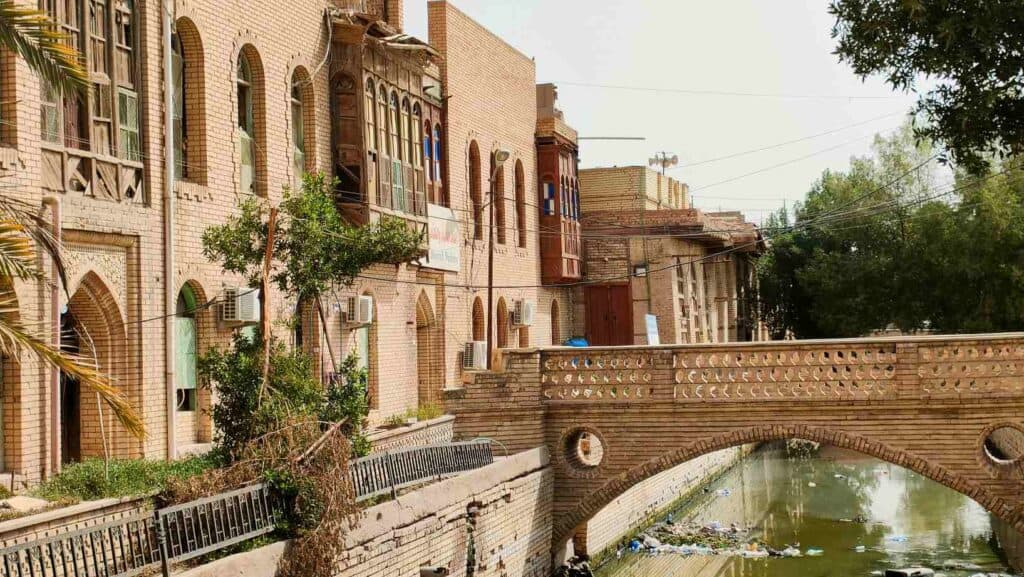
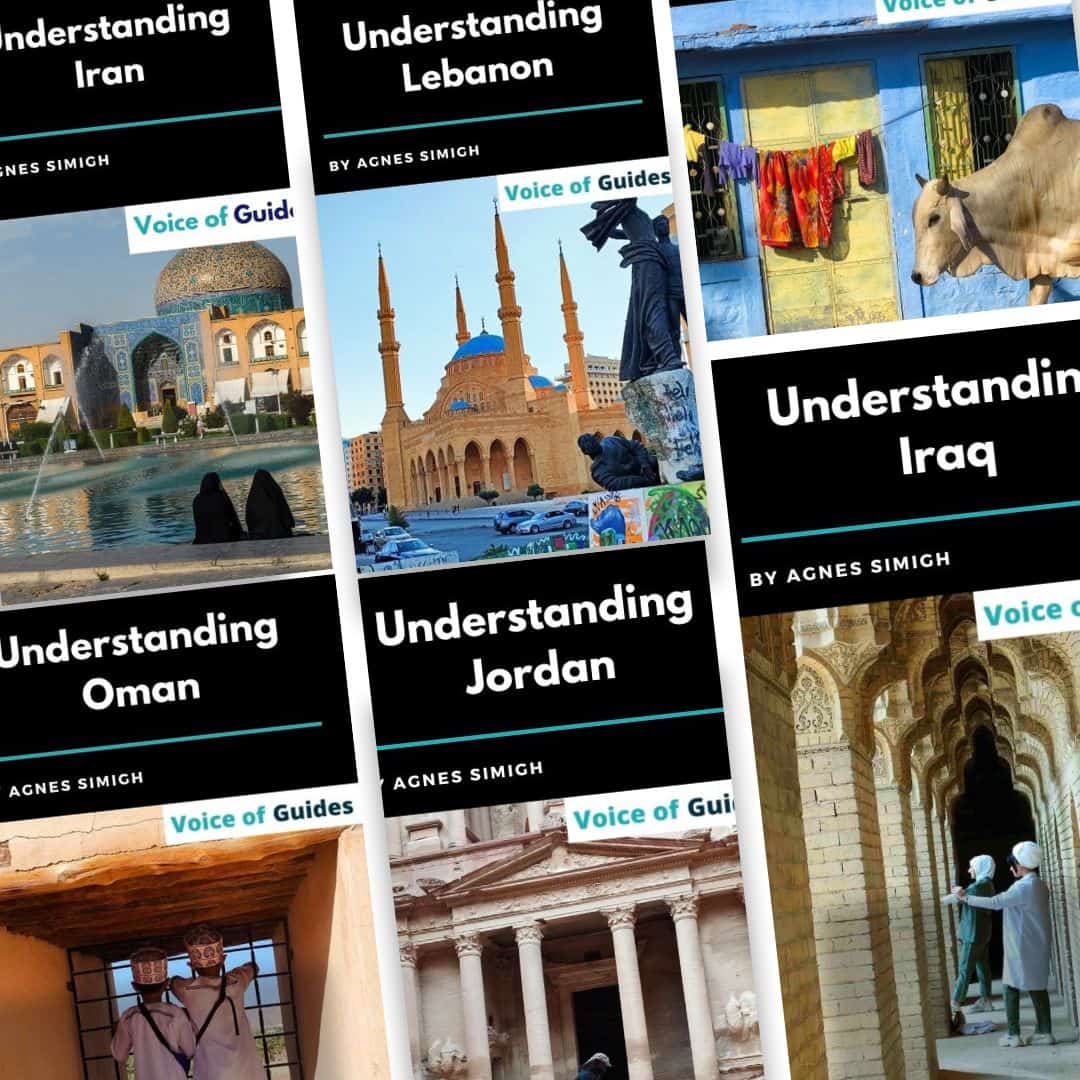
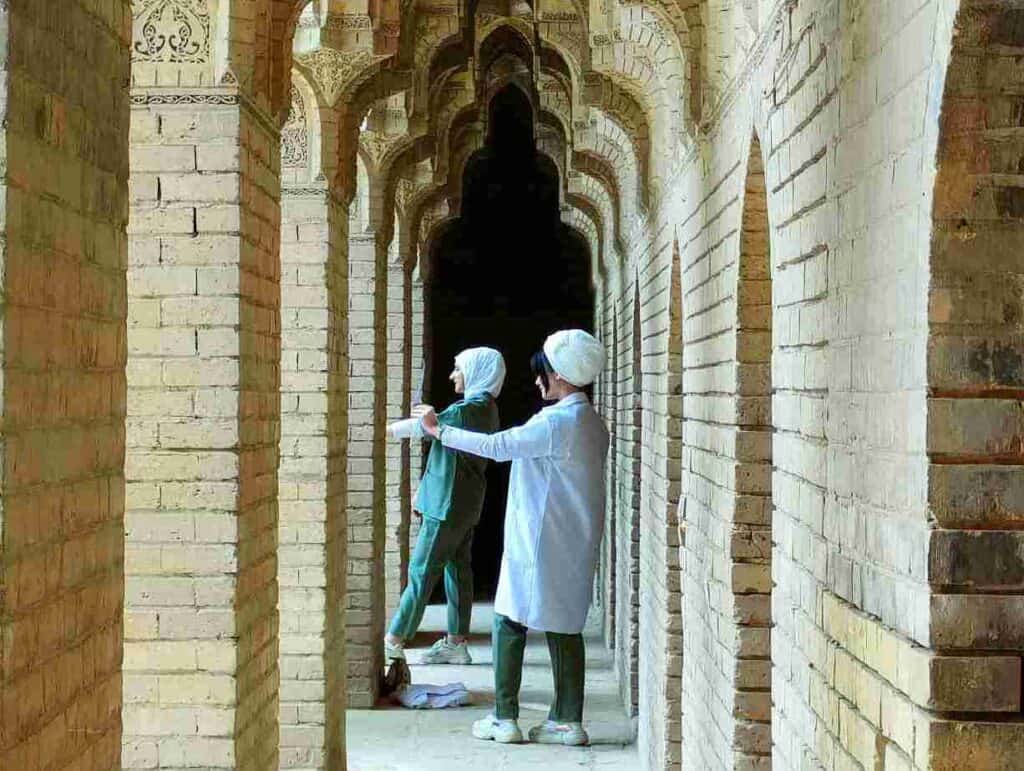
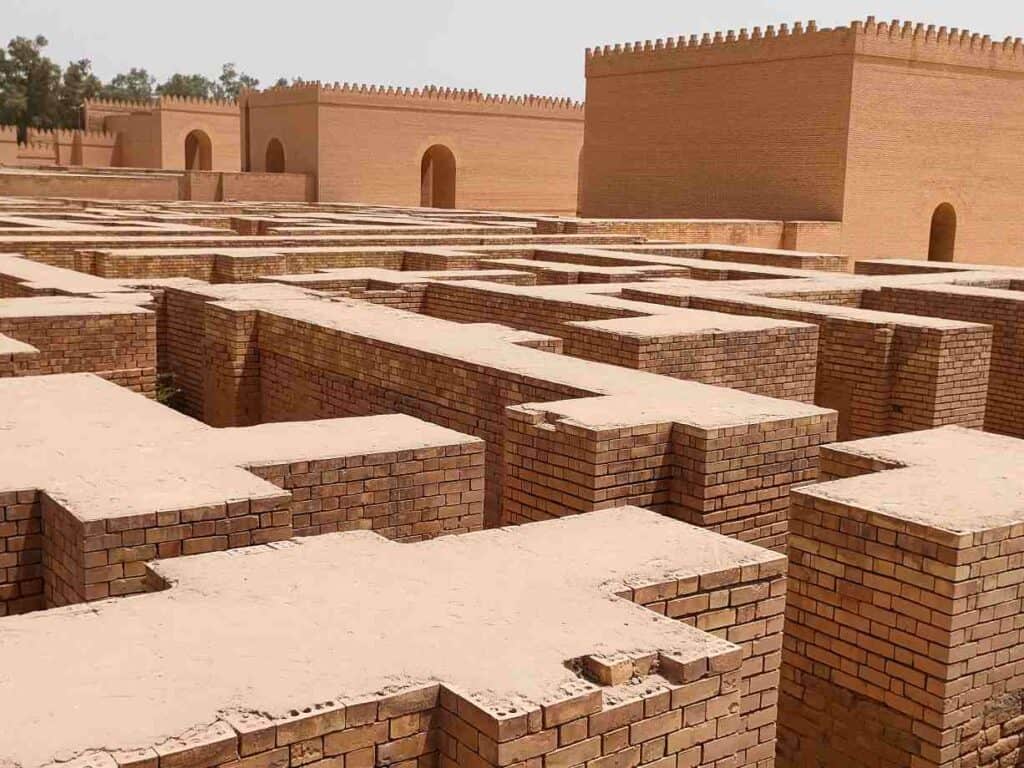
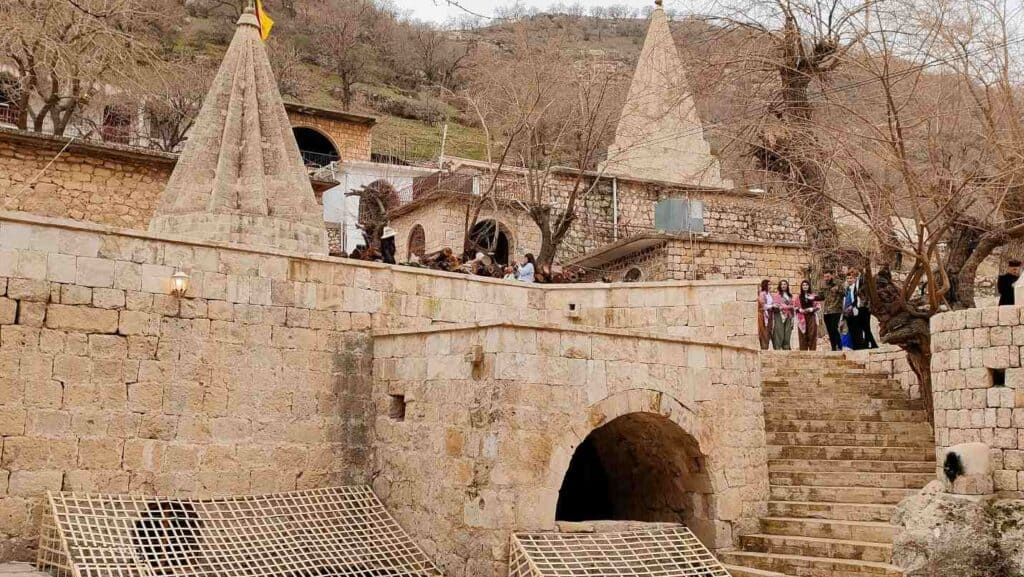
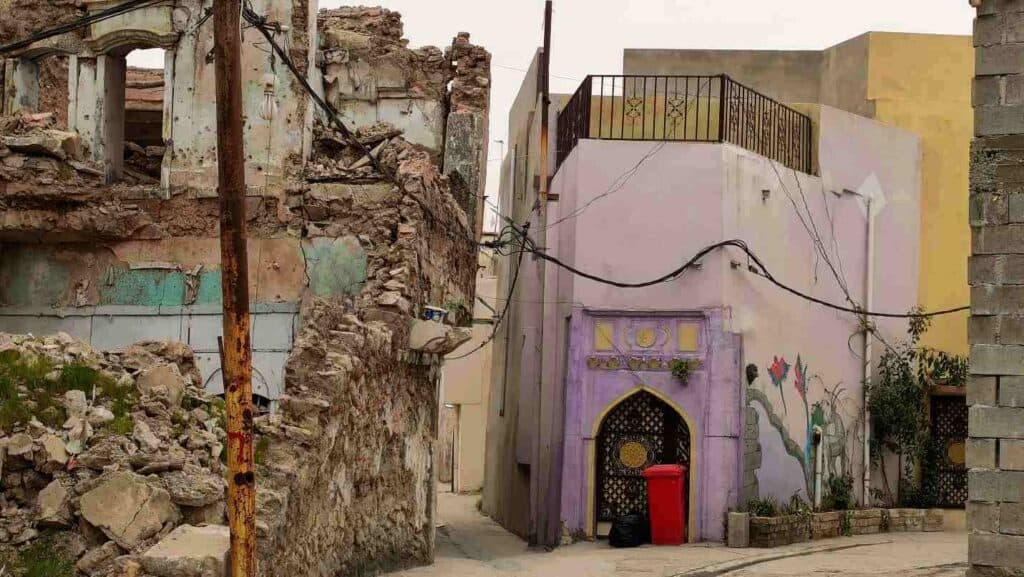
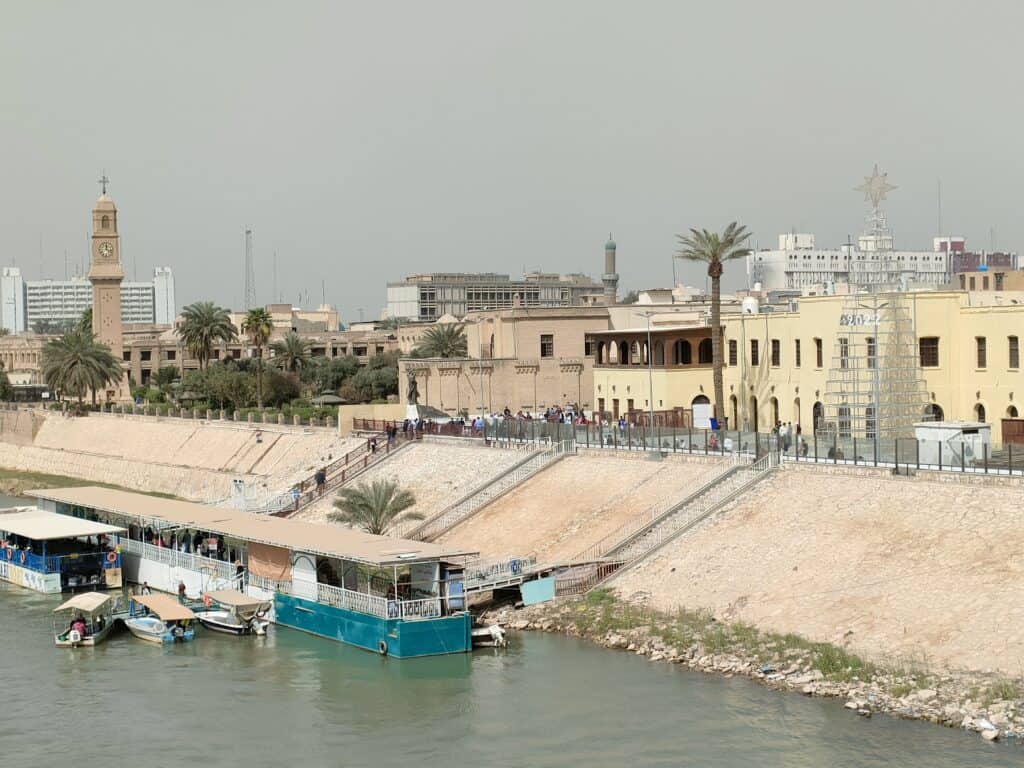
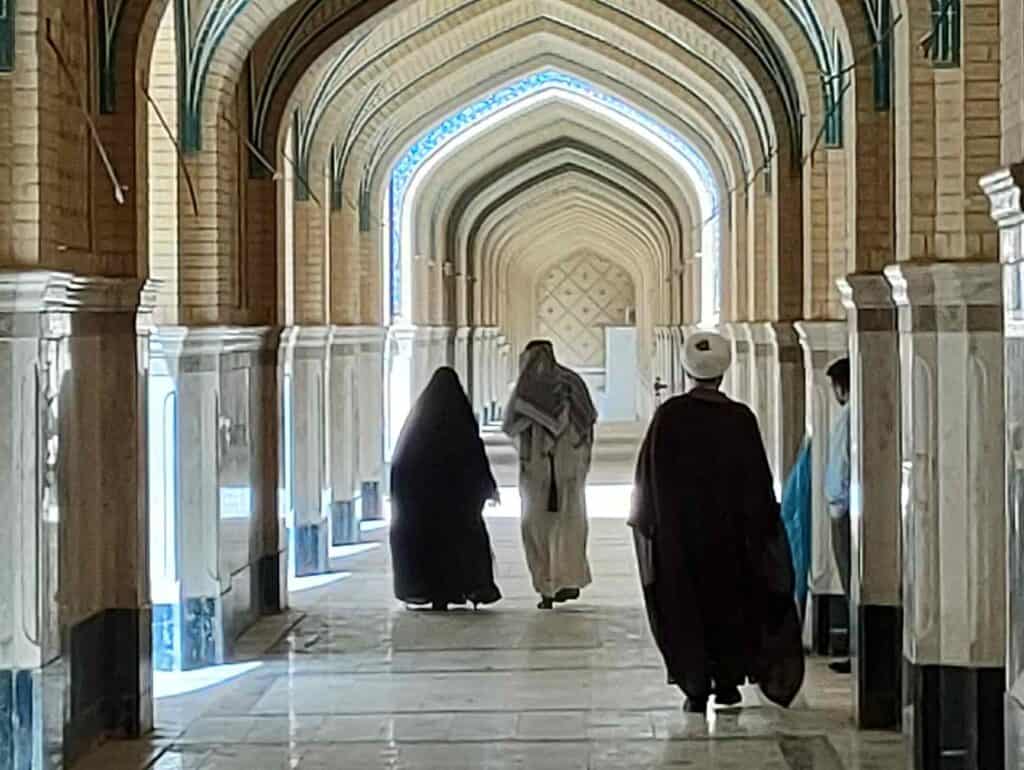
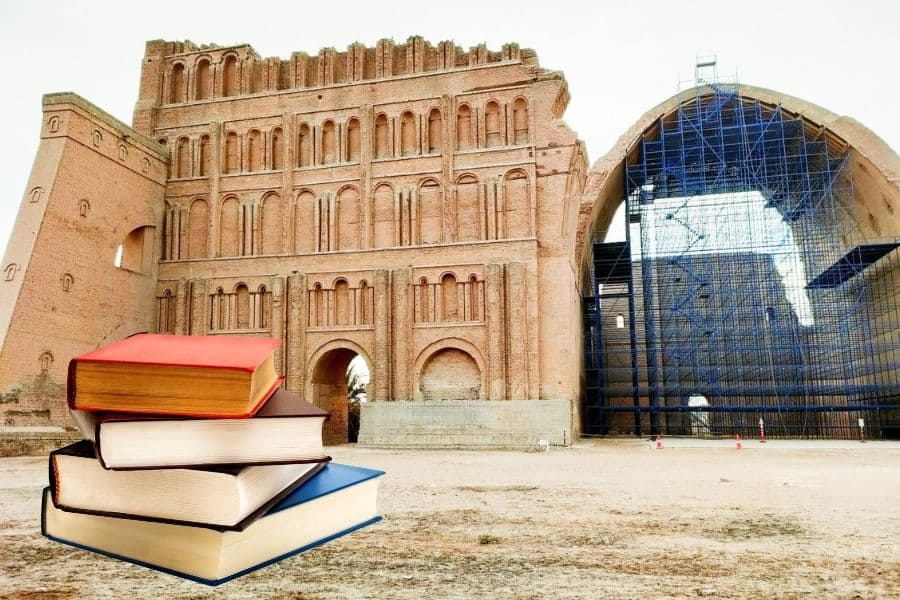

There was an ancient historical site we visited in Basra 1983,…THE GARDEN OF EDEN…a huge old tree trunk was inclosed into a glass in look like neglected park,few other grown trees around and at the distance about 500meters away are dates plantation and when we look closely we realized war tanks and bunch of uniform soldiers are there,we exited fast and travel back to Baghdad via Kerbala.Hope this place still existing,run through your travel guide but of no mention, I was just so proud to reach this place.
hi!Thanks for your comment. The garden of Eden with Adam’s tree is in Qurnah, one hour’s drive from Basra at the confluence of the Tigris and Euphrates rivers. I think this is what you mean. I mention it in my travel guide about the best places to visit in Iraq.Hope this helps.